
Alberta’s climate has changed and will continue to change in the coming decades. The province’s mean annual temperature is expected to rise 2°C by the 2030s and 4°C by the 2060s (compared to the 1990s) should the current rate of global greenhouse gas emissions remain unchanged. This level of warming is greater than the projected increase for the globe as a whole. Precipitation levels and patterns will likewise change; total average annual precipitation is projected to increase, but with precipitation levels likely increasing in the winter and declining in the summer.
Alberta’s climate is also expected to become more variable, leading to greater risk of extreme weather such as flash floods, severe rain and hail storms, heat waves, lightning and tornados and long term stresses such as droughts, changes in seasonality and increase of pest, diseases & invasive species. These projected changes have significant implications for Alberta’s economy, society and environment. Should global greenhouse gas emission rates decline, the change in Alberta’s climate will be less severe but still significant.




